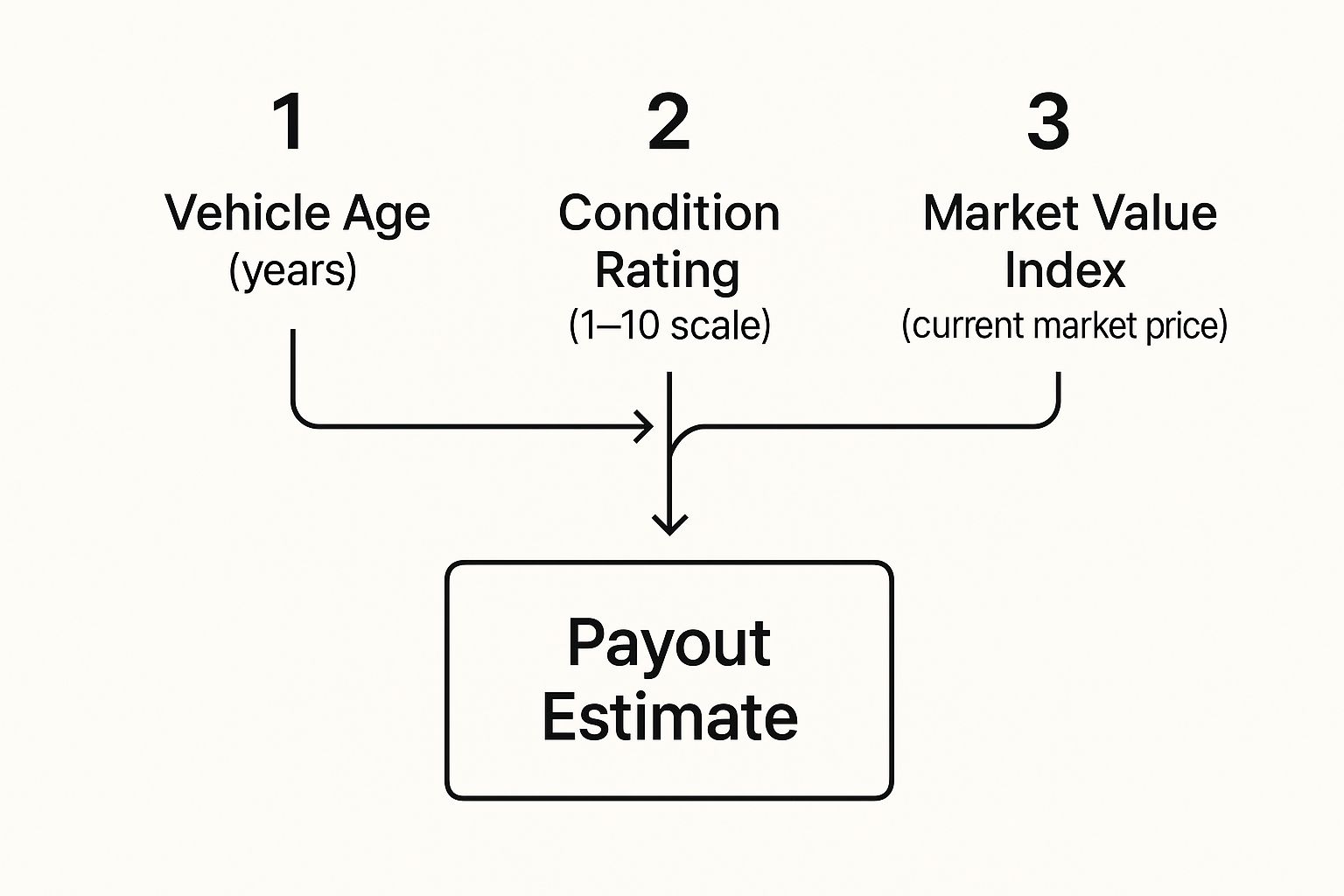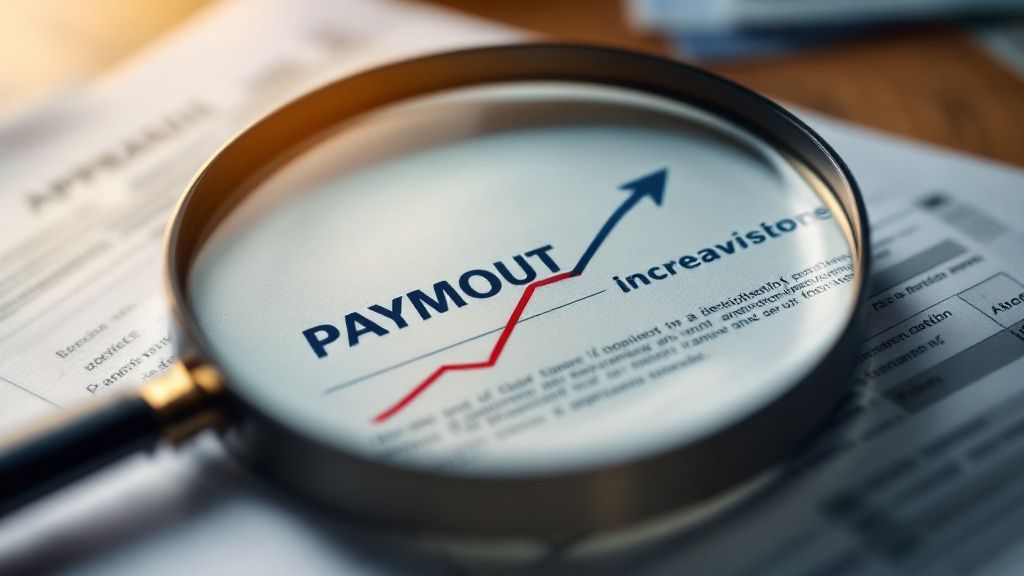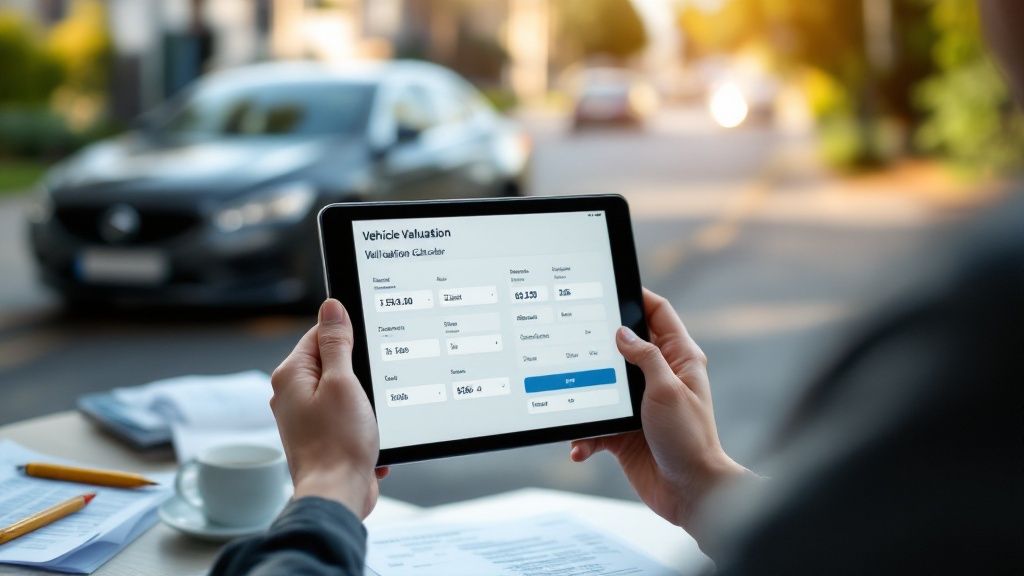When an insurance company calls your car a "total loss," their first offer is almost never their best offer. Think of it as an opening bid. A total loss vehicle value calculator is the first tool you should reach for. It gives you the power to understand what your car was really worth, arming you with the data you need to negotiate a fair settlement.
Why Getting Your Car's Value Right Matters So Much
Hearing that your car is a total loss is a gut punch. It’s stressful, and it's easy to just accept what the insurance company tells you. But right now, being informed is your best defense against leaving money on the table.
More cars are being totaled today than ever before, and it's not always because of massive, crushing damage. The reality is a perfect storm of factors that directly hits your wallet.
The New Math of a Total Loss
Today’s cars are rolling computers. What looks like a simple fender-bender can easily damage a whole network of sensors, cameras, and other advanced tech buried in the bumper. Suddenly, a seemingly minor repair job has a price tag that spirals into the thousands.
When the cost to fix your car gets too close to what it’s worth, the insurer will just write it off. That threshold is surprisingly easy to hit these days.
At the same time, we've seen wild swings in the car market. Supply chain hiccups and inflation have pushed both new and used car prices way up. This means the very car that would have been repaired a few years ago is now more likely to be declared a total loss. The high cost of tech-heavy repairs often bumps right up against its inflated market value.
This is exactly why you need to get a firm handle on your vehicle’s Actual Cash Value (ACV). The ACV is the fair market price your car would have sold for the moment right before the accident.
Key Takeaway: The insurance adjuster's first number comes from their own data, which often overlooks your car's specific condition, any recent upgrades you made, or what similar cars are actually selling for in your town. Your own research is what makes up the difference.
This is where a good total loss calculator becomes your secret weapon. It gives you a realistic, data-driven number to start your negotiations. You're no longer just taking what you're given; you become an informed participant in your own claim. To really dig in, it’s worth understanding what the actual cash value of your car truly means.
Gathering Your Vehicle's Essential Details

Before you even think about plugging numbers into a total loss vehicle value calculator, you need to do a little homework. Think of yourself as building a case for your car's true worth. The insurance adjuster will have the basics, but it's your job to paint the full, detailed picture that they don't have.
First, let's nail down the non-negotiables: your Vehicle Identification Number (VIN), the exact mileage on the day of the accident, and the specific trim level. That last one is a big deal. People often forget if they have the LX, EX, or Touring model, but that single detail can swing the value by thousands of dollars. Your best bet is to find the original bill of sale to be certain.
Documenting Your Car’s Condition and Upgrades
Now we get to the part where you can really move the needle on your settlement. We need to gather concrete proof that your car was in great shape and had features that added to its value. This is how you build an undeniable claim.
Your evidence file should be packed with anything that shows your car was well cared for. Start collecting:
- Maintenance Records: Dig up every service receipt you can find from the last couple of years. Regular oil changes, new brakes, tire rotations—it all tells a story of a vehicle that was maintained properly.
- Recent Big-Ticket Items: Did you just shell out $800 for a new set of tires? Or maybe you replaced the battery a few months back? These aren't just maintenance; they are recent investments that add real, provable value. Get those receipts.
- Factory Options & Packages: The insurer's initial report often misses things. Make a list of every single feature that wasn't standard on the base model, like a sunroof, a premium audio system, or an advanced safety package.
- Quality Aftermarket Additions: If you added a remote starter, high-quality window tint, or a set of custom wheels, these can also boost the value. Just make sure you have the receipts to prove what you spent.
This prep work is what separates a standard, take-it-or-leave-it offer from a successful negotiation. You’re not just telling the adjuster your car was worth more; you're showing them with a mountain of proof. Every document you find is a tool to counter a lowball offer.
How To Get The Most Out of a Total Loss Value Calculator
This is where the rubber meets the road. You’ve gathered all your paperwork, and now it's time to turn that information into a solid dollar figure. Using a total loss vehicle value calculator isn't just about plugging in numbers; it’s about understanding why you’re plugging them in and how each field impacts the final estimate. Getting this part right is everything.
You’ll begin with the easy stuff: VIN, make, model, year, and mileage. But the field that requires your real attention—and has the biggest impact—is your vehicle's condition. It's tempting to just select "Good," but you need to be honest and, more importantly, detailed. A car with a few minor dings but a meticulously maintained engine is very different from one with a faded interior and aging tires. Think like a buyer.
The visual below breaks down how factors like age, condition, and market trends come together to determine that final settlement number.

As you can see, the condition you report directly shapes the market value the calculator uses. That's why a precise, honest assessment is so critical to getting a fair shake.
Getting The Details Right For Maximum Payout
Once you’ve nailed the basics, you'll get to the optional features. Do not skip this section. That factory-installed sunroof, the premium audio system, or the driver-assist package you paid thousands for adds real, demonstrable value. Insurance adjusters often gloss over these details in their initial offer, so it's on you to itemize everything.
Where you live also makes a surprising difference. A 4×4 truck might be worth 10% more in a rural, snowy region than it is in a sunny, urban area. The calculator uses your ZIP code to tap into local market data, ensuring the estimate reflects what people are actually paying for cars like yours, right in your backyard.
To get the most accurate result, you need to understand what the calculator is asking for. These are the inputs that matter most.
Key Inputs and Their Impact on Vehicle Value
| Data Input | Why It Matters | Example of Impact |
|---|---|---|
| Vehicle Condition | This is the most subjective yet influential factor. It directly adjusts the base value up or down based on wear and tear. | Choosing "Excellent" over "Fair" can increase a vehicle's value by thousands, but it must be backed by evidence (service records, photos). |
| Optional Features | Insurers often use a base model for their valuation. Adding factory-installed options corrects this and increases the value. | A $2,500 premium tech package, if forgotten, is $2,500 left on the table. |
| Geographic Location | Market demand varies significantly by region. A vehicle's value is tied to what local buyers are willing to pay. | A convertible will have a higher valuation in Southern California than in Alaska, reflecting local demand. |
| Recent Maintenance | Proving you recently invested in major components like new tires or a timing belt can add direct value. | Submitting a receipt for $1,200 in new tires can add a significant portion of that cost back to the vehicle's value. |
These details are what separate a lowball offer from a fair settlement. The more evidence you provide, the stronger your position becomes.
A Note From The Trenches: Insurers don't just guess a number. They use sophisticated, data-driven platforms to generate their offers. These systems automatically decode your VIN and compare it against huge databases of similar vehicles sold recently. Your job is to fill in the gaps they miss—like that premium package or those brand-new tires.
At the end of the day, these calculators are trying to replicate the complex valuation systems used by the pros. The best services, like those from Mitchell, combine pricing data with decades of appraisal expertise to generate their figures. Understanding how these tools work gives you a massive advantage.
For a closer look at the calculations, our guide on the car value after accident calculator offers even more specific insights.
Turning a Calculation Into a Check

The number you get from a total loss vehicle value calculator is a great start, but it's not the final word. Think of it as your opening argument. It provides a solid, data-driven estimate of your car’s Actual Cash Value (ACV), but to an insurance adjuster, it's just a figure on a screen.
Your job now is to connect that number to the real world. This is where "comparables" (or "comps") come in. By finding real cars, just like yours, for sale in your area, you turn your estimate into a hard-to-ignore market value. You're showing the adjuster exactly what it would cost you, right now, to buy a replacement vehicle.
Finding Comps That Count
First thing's first: keep it local. An adjuster handling a claim in Austin, Texas, isn't going to care about the price of a similar car in Portland, Oregon. Your local market is the only one that matters.
Your search needs to be surgical. You're trying to find your car's twin. Hop onto major online car marketplaces or local dealership websites and use their filters to get as specific as possible.
Here's what to zero in on:
- Make, Model, and Year: The non-negotiable basics.
- Trim Level: A base model isn't the same as a fully-loaded one. This detail is critical.
- Mileage: Aim for comps within 10-15% of your car's mileage when the accident happened.
- Condition: Look for listings with descriptions that match your car's pre-accident condition.
- Options and Packages: Did you have a sunroof, leather seats, or a premium sound system? Find comps that do, too.
My Advice: Don't just browse. Document everything. Save screenshots or print the actual listings for at least three to five of the strongest comps you find. Make sure you capture the dealership's name, the VIN, asking price, and a list of the features. This is the evidence you’ll bring to the negotiation table.
When you walk into that conversation armed with your calculator results and a folder full of real-world comps, the dynamic shifts completely. You're no longer just another person questioning the insurance company's lowball offer. You're presenting a well-researched, fact-based case for what you're owed, backed by undeniable market data. This single step can make all the difference.
Negotiating Your Settlement with Confidence
https://www.youtube.com/embed/ttGH-cssf_s
Alright, you've done the hard work. You have your valuation report from the calculator and a solid list of comparable vehicles. Now, it's time to talk to the insurance adjuster.
The key thing to remember is that their first offer is almost never their final offer. Think of it as a starting point for a conversation, not a final decision. Your preparation is what gives you the leverage to steer that conversation in the right direction.
When you present your case, stay calm and stick to the facts. Instead of just saying, "Your offer is too low," which can put them on the defensive, try a more collaborative approach. You could say something like, “I appreciate you sending this over. After reviewing your valuation, I noticed it seems to be missing the premium technology package my car had, and the mileage is listed about 5,000 miles too high. I’ve put together some research on local vehicles with the correct features that I can send you.”
This simple shift in tone changes the dynamic from a confrontation to a factual correction. You're not attacking their number; you're working with them to make it more accurate.
Proving What Your Car Was Really Worth
This evidence-based approach is absolutely essential, especially if your car was a bit older. Total loss claims are on the rise, and a huge chunk—over 70%—of these valuations are for vehicles that are seven years or older.
In fact, a recent industry report showed that 22.6% of all insured losses were total losses, which is a significant jump from previous years. You can dig into these trends in CCC Intelligent Solutions' Crash Course 2025 report. This means adjusters are dealing with older cars all the time, but their automated valuation systems often miss the mark on a well-maintained model that has real market value.
Pro Tip: Never, ever accept an offer on the first phone call. Politely thank them for the offer and ask them to email you their official valuation report. That document is your roadmap—it shows you exactly how they calculated their number and gives you specific points to counter with your own research.
When you come back with a well-documented case built on your total loss vehicle value calculator results and real-world local comps, you show the adjuster you're serious and informed. For a deeper dive into tactics, check out our guide on how to effectively negotiate your total loss settlement. This level of preparation builds your credibility and makes it very difficult for them to justify sticking with a lowball offer.
Common Questions About Total Loss Claims

Going through a total loss claim can feel overwhelming, especially when you're hit with unfamiliar terms and processes. Let's walk through some of the most common questions I hear from clients to give you the clarity and confidence you need.
One of the biggest anxieties is getting a lowball offer from the insurance company. If their number seems way off from your own research, that’s your signal to dig deeper. Scrutinize their valuation report for any mistakes—is the mileage correct? Do they have the right trim level, options, and condition listed? Don't be afraid to politely push back and ask them to show you the specific market data they used to justify their lower figure.
Addressing Key Claim Scenarios
A question that comes up all the time is whether recent repairs or maintenance can increase the value. The answer is a firm yes. If you’ve made significant investments—like putting on a brand-new set of tires or completing a major service right before the accident—that adds to your car's Actual Cash Value (ACV).
You won't get a one-for-one reimbursement, but providing those receipts proves your vehicle was in better-than-average condition, which absolutely supports a higher valuation.
What about an outstanding car loan? This is a crucial point. When your car is declared a total loss, the insurance payout goes to your lender first to clear the loan balance.
You only get what’s left over. If the settlement amount is less than what you still owe on the loan (often called being "upside-down"), you’re on the hook for that difference. This is exactly why GAP insurance is so valuable—it’s designed to cover that gap and protect you financially.
It's always smart to be prepared for potential roadblocks. Taking some time to understand the reasons an insurance company might refuse a claim and potential remedies can make a world of difference. And if the insurer simply won't budge on a fair number, remember you have a powerful tool in your policy: the appraisal clause. This lets you hire your own certified appraiser to get an independent, unbiased valuation.
If you're stuck with a lowball offer, don't just accept it. The team at Total Loss Northwest specializes in invoking the Appraisal Clause to secure the fair settlement you're entitled to. Contact us today to ensure your claim is valued correctly.





